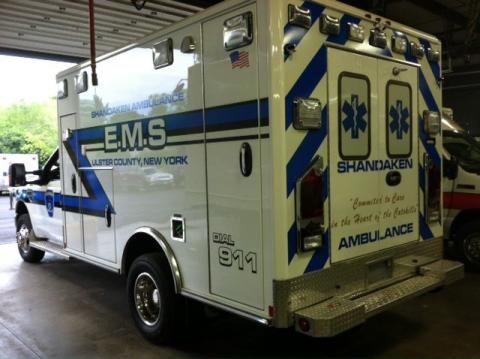
Photo of a Shandaken ambulance, from the Shandaken Ambulance Service's Facebook page.
Like much of the rural Catskills, the town of Shandaken is a virtual black hole for cell phone coverage. Despite years of efforts by the town and its citizens to lure cellular providers to the region, most of the town is a cell-phone dead zone.
For most residents, it's an inconvenience. For emergency first responders, it's a life-or-death issue, especially when a patient is suspected of having a heart attack.
Shandaken Ambulance Service captain Rich Muellerleile is tired of waiting for the likes of Verizon, AT&T, Sprint or T-Mobile to install potentially lifesaving cell coverage across the town. At the most recent town meeting, on Monday, Feb, 6, Muellerleile reached out directly to town residents, imploring anyone who has a Verizon network extender at their home or business to allow the ambulance service to borrow their network connection if an emergency arises. The Daily Freeman wrote about Muellerleile's appeal to the town in today's paper.
Since appearing at the meeting on Monday, Muellerleile says, he's gotten dozens of phone calls and emails from citizens volunteering to have their Verizon network extenders put on a map to help the Shandaken Ambulance Service stay connected.
Muellerleile has been amazed by the town's generous response.
"It's wicked cool," he said. "We were thinking we'd maybe get four or five people."
Some people are even volunteering to buy extenders to help the cause, Muellerleile said.
"I had a representative from a local church in Big Indian say they'd like to put an extender on a steeple," he said.
Cell service: Vital for heart patients
Network extenders are small devices that work like miniature cell phone towers, allowing anyone with a high-speed Internet connection to create a short-range cell phone signal. They currently cost around $250.
The Shandaken Ambulance Service's vehicles are equipped with heart monitors that can transmit data wirelessly over a Verizon network. The devices can send electrocardiograph data to a hospital while the patient is still en route, allowing the doctor to diagnose a heart attack, prepare ahead of time for the patient's arrival, or even order medication to be given in the ambulance.
Sending data to the hospital in advance can buy much-needed time for a patient in a remote area who is having a heart attack, said Muellerleile.
"It allows the hospital to paint a picture of the patient, and also allows for faster treatment," he said. "When we're dealt a 35-minute transport time at best, we need as much working for us as we can get up here."
Last year, Muellerleile said, the Shandaken Ambulance Service got 42 calls for chest pain or suspected heart attack.
Rural New Yorkers have a well-deserved reputation for being self-reliant -- and by cobbling together a citizen network of cell phone access points in an area that's long been ignored by big providers, Shandaken residents are proving themselves to be as resourceful as their farming forebears.
"It's really a cool thing. We're dealt a certain deck of cards and we can't change that," said Muellerleile. "But we're trying to work with these progressive ideas to get better patient care out there."













